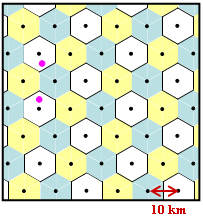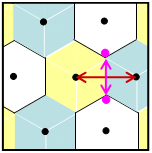Exercise 3.3: Cellular Mobile Communications Systems
From LNTwww
(Redirected from Exercises:Exercise 3.3: Cellular Mobile Communications Systems)
A characteristic of GSM and UMTS alike is the cellular network structure, whereby for simple calculations the cells are often approximated by hexagons.
- The colours "white", "yellow" and "blue" in the diagram stand for different frequencies, which can reduce the disturbing influence of intercell interference.
- Black dots indicate base stations that are evenly distributed in this model at a distance of $D = 10 \ \rm km$ .
- The two violet dots in the upper left-hand corner indicate two mobile stations whose signals interfere with each other –
see subtask (2).
Notes:
- The task belongs to the chapter Similarities between GSM and UMTS.
- In particular there are questions in this task concerning Cell Breathing and Near–Far effect.
Fragebogen
Solution
(1) Correct is the solution 1:
- From the coloring of the graphic on the data page you can see the reuse–factor 3.
- In GSM, adjacent cells use different frequencies.
- In the CDMA based UMTS system, however, the same frequency is used in all cells.
(2) Correct is the solution 2:
- Intercell interference occurs between the mobile stations shown, since the participants of "different cells" use the same frequency channel.
(3) The sketch illustrates the calculation process with regard to the "white frequencies", where $d_{\rm min}$ is given by the purple arrow.
- The mobile stations are then located in the corners of the white hexagons.
- The red (horizontal) arrow marks the distance $D = 10 \ \rm km$ between two base stations.
- Based on simple geometric considerations, one obtains
- $$\tan(30^{\circ}) = \frac{d_{\rm min}/2}{D/2} \hspace{0.3cm}\Rightarrow \hspace{0.3cm} d_{\rm min} = D \cdot \tan(30^{\circ}) \hspace{0.15cm} \underline {= 5.77\,{\rm km}}\hspace{0.05cm}.$$
(4) Correct are both solutions:
- If the number of active participants increases significantly in UMTS, the cell radius and thus the current interference power is reduced.
- For the supply of mobile subscribers at the edge of a busy cell, a less busy neighboring cell then steps in.
(5) Correct are the both first solutions:
- The Near-Far effect describes the problem of the uplink. The base station receives a much weaker signal from a farther away user than from a nearby subscriber.
- The bit error rate is then all the greater, since the signal of the farther party is largely obscured by the near party.
- The Near-Far effect can be largely compensated for, e.g. by a fast and precise power control, in which the more distant subscriber transmits with greater power.
- However, such an increase in power also causes greater interference power for all other users, so that a compromise must always be found.
- By using so-called multi-user detectors, the Near-Far effect can be compensated sufficiently well, even with uniform transmission power.
- This type of receiver is mainly used at the base station - in the uplink. But it is also used in the downlink, for example to subtract the BCH or pilot channel.

